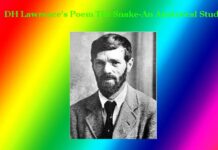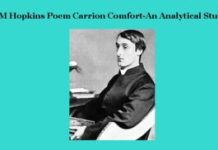The Use of Myth and Symbolism in The Waste Land
The Use of Myth and Symbolism in T.S. Eliot’s ‘The Waste Land’
The Use of Myth and Symbolism in The Waste Land
A Myth is a fictitious story of unknown authorship having its roots in the primitive beliefs of a race or nation that presents supernatural episodes as a means of interpreting some natural events concerning how something comes to exist. On the other hand, a Symbol is an object- animate or inanimate- that stands for something else. In a literary sense, when an object is used to represent, illustrate, clarify, deepen, reinforce or intensify the meaning or significance of something else is called Symbol. T.S. Eliot used some symbols in his epic-like poem ‘The Waste Land’. Let us discuss the use of myths and symbols in the poem as below:
Besides abundant use of allusions, references and quotations T. S. Eliot has employed three myths, as- (i) the Myth of the Holy Grail, (ii)the Myth of Fertility and (iii) the Myth of Tiresias as extended metaphors to represent the intellectual and spiritual barrenness and sterility of modern human civilization. The myths serve as a continuous parallel between contemporaneity and antiquity. The sources of Eliot’s myths used in this poem are- (i) Miss Waston’s ‘From Rituals and Romance’ and (ii) Frazer’s ‘The Bough’. We can recount these myths as below:
The Myth of the Holy Grail
According to the Grail Legend, the ‘Grail’ (bowl-shaped drinking cup) was used by Jesus Christ at his last supper with his disciples before he was put to the Cross. The myth says that the Grail was supposed to have been brought to England by a mythical early Christian saint named Joseph of Armathea. It had been the symbol of holiness and an object of a quest for the chivalrous knights. But the story relevant to Eliot’s poem concerns the Grail and the Fisher King. The Grail was in possession of the Fisher King or at least the king knew the whereabouts of it. But the king was a sinner of adultery, fornication and other abnormal sexual acts. As a curse, the whole kingdom was afflicted with drought and the land had become waste and sterile. But eventually, one of the king’s knights, who went through the ordeals of the way, reached the Chapel Perilous and both asked and answered himself certain right questions and right answers and then the king along with his land got cured of the curse. This myth represents that through sufferance and penance one can get rid of the curse of sins and spiritual peace may be regained.
The Myth of Fertility
Several stories are connected with this Myth of Fertility. One is of the god of Fertility called Orisis in Greek Mythology. According to a ritual, the effigies of Orisis with some corn grains are buried under the earth after yearly crop harvesting. But soon the grains that are buried with the effigy germinate. The burial of the effigy of Orisis symbolizes ‘death’ and the subsequent germination of corn symbolizes ‘rebirth’. Secondly, the myth of fertility has been adopted in the Christian Myth as- the birth, crucifixion and resurrection of Jesus Christ. Thus by this fertility myth, the poet Eliot wants to represent that spiritual regeneration is possible through devotion to God and Christ.
The Myth of Tiresias
In Greek Mythology, Tiresias is represented as a blind, hermaphrodite and soothsayer. According to the myth, once he happened to see the goddess Athena enjoying a naked bath and then being offended the goddess turned Tiresias blind. Another story says that once he disturbed a pair of copulating serpents with his stick and they being angry, transformed Tiresias into a woman; but after seven years, he again happened to disturb another pair of serpents who turned him into a man. Thus Tiresias had got the experiences of both a man and a woman. Tiresias in this way serves obviously as a connecting link between the wasteland of the past and of the present. The Myth of Tiresias serves as the parallel between the past and the present in this respect that sexual passion makes the present age as sterile as that of the past as happened during the times of King Oedipus.
In addition to the use of all these myths and their significances, the poet has employed abundant symbols, as- the fertility theme is projected through the symbolism of ‘spring’, ‘rain’, ‘wet hair’, ‘vegetation’ and ‘flower’. ‘Spring’ symbolizes ‘life and regeneration, but to the waste Landers, it is a symbol of ‘decay’. Thus the ‘rain and flower’ symbolize spiritual rebirth’; ‘dog’ in the poem symbolizes ‘human conscience’; the ‘rock’ stands for the wrath of God’, ‘broken Coriolanus’ symbolizes ‘human pride and ego’; ‘King Fisher with his Trishul’ symbolizes the’ threefold ways to salvation. The ‘card’ with the picture of a wheel stands for the ups and downs of life.
Thus, the poet has successfully brought about the uses of myths and symbols to represent his theme of the sterility of human intellect and conscience as a parallel to the past and present. But the uses of those myths and symbols have imparted complexity and obscurity to the poem for which the poem is not easily appreciable by the general readers. 0 0 0
The Use of Myth and Symbolism in The Waste Land
Read More: The Art of Characterisation in Chaucer’s Canterbury Tales
The Use of Myth and Symbolism in The Waste Land
N. B. This article entitled ‘The Use of Myth and Symbolism in The Waste Land” originally belongs to the book ‘Critical Essays on English Poetry‘ by Menonim Menonimus. The Use of Myth and Symbolism in The Waste Land
Books of Literary Criticism by M. Menonimus:
- World Short Story Criticism
- World Poetry Criticism
- World Drama Criticism
- World Novel Criticism
- World Essay Criticism
- Indian English Poetry Criticism
- Indian English Poets and Poetry Chief Features
- Emily Dickinson’s Poetry-A Thematic Study
- Walt Whitman’s Poetry-A Thematic Study
- Critical Essays on English Poetry
- Tawfiq al-Hakim’s Novel: Return of the Spirit-An Analytical Study
- Tawfiq al-Hakim’s Novel: ‘Yawmiyyat Naib Fil Arayaf’-An Analytical Study
- Analytical Studies of Some Arabic Short Stories
- A Brief History of Arabic Literature: Pre-Islamic Period …
Related Searches:











